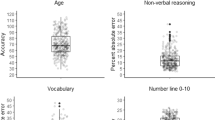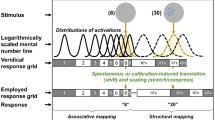Abstract
Metacognitive monitoring, recognizing when one is accurate or not, is important because judgments of one’s performance or knowledge often relate to control decisions, such as help seeking. Unfortunately, children and adults struggle to accurately monitor their performance during number-magnitude estimation. People’s accuracy in estimating number magnitudes is related to math achievement and health risk comprehension. Thus, poor monitoring of number-magnitude estimation performance could pose problems when completing math tasks or making health decisions. Here, we evaluated why monitoring accuracy was so poor during number-line estimation, whether it was greater in the presence of a cue that was predictive of performance or when accounting for spatial skills, and the relation between monitoring judgments and control. Monitoring accuracy was greater in a condition in which familiarity, a cue adults commonly rely on to monitor their performance in this task, was predictive of estimation accuracy, compared to a condition in which familiarity was misleading. Although indices of monitoring accuracy did not improve when accounting for spatial skills, reducing variability by dichotomizing estimation performance into accurate or not improved monitoring accuracy metrics. Accurate monitoring was important because adults were more likely to ask for help when they were less confident in their estimate. Taken together, our data on monitoring accuracy suggested that (a) using cues predictive of accuracy is important for monitoring in number-line estimation, (b) adults are poor at detecting small differences in their performance, and (c) prior estimates of monitoring accuracy in number-line estimation may underestimate people's true monitoring ability.








Similar content being viewed by others
Notes
Note that screen resolution and CSS pixels often differ because screen resolution, which reflects screen size multiplied by pixel density, has increased in recent years. CSS pixel width and height is a more accurate reflection of screen size than resolution, or total number of pixels.
If participants exceeded the time constraint, the window flashed and prompted them to: “Please respond within the time limit” but still permitted them to answer the item. Thus, there were no missing data on the number-line estimation task.
Recall that continuous predictors were rescaled by dividing the within-person mean centered variables by 100. We rescaled here for interpretation.
We rescaled confidence here to be on the same 100-point scale as PAE. Recall that in the primary analyses, we rescaled within-person mean centered confidence by dividing by 100.
We predicted confidence judgments from condition and help seeking (yes or no) in a mixed effects model. Confidence was lower in the diagnostic than non-diagnostic cue conditions, b = -10.53, p < .001, and when participants asked for help compared to when they did not, b = -12.09, p < .001. An interaction (b = -15.41, p < .001) revealed that confidence was similar for small-component items between conditions but lower when participants asked for help in the diagnostic (M = 42.0, SE = 3.72) than non-diagnostic cue (M = 60.20, SE = 3.79) conditions. And, in the non-diagnostic cue condition, confidence was similar when they asked for or did not (M = 64.6, SE = 3.59) ask for help p = .096.
Note that we multiplied gamma values by -1 because our measure of estimation accuracy was a degree of error. Thus, gamma values closer to 1 reflect more accurate monitoring with this coding.
References
Alibali, M. W., & Sidney, P. G. (2015). Variability in the natural number bias: Who, when, how, and why. Learning and Instruction, 37, 56–61. https://doi.org/10.1016/j.learninstruc.2015.01.003
Baars, M., Wijnia, L., de Bruin, A., & Paas, F. (2020). The relation between students’ effort and monitoring judgments during learning: A meta-analysis. Educational Psychology Review, 32, 979–1002.
Bates, D., Maechler, M., Bolker, B., & Walker, S. (2015). Fitting linear mixed-effects models using lme4. Journal of Statistical Software, 67(1), 1–48. https://doi.org/10.18637/jss.v067.i01
Booth, J. L., & Siegler, R. S. (2006). Developmental and individual differences in pure numerical estimation. Developmental Psychology, 42(1), 189. https://doi.org/10.1037/0012-1649.41.6.189
Booth, J. L., & Siegler, R. S. (2008). Numerical magnitude representations influence arithmetic learning. Child Development, 79(4), 1016–1031. https://doi.org/10.1111/j.1467-8624.2008.01173.x
Braithwaite, D. W., & Siegler, R. S. (2018a). Children learn spurious associations in their math textbooks: Examples from fraction arithmetic. Journal of Experimental Psychology: Learning, Memory, and Cognition, 44(11), 1765.
Braithwaite, D. W., & Siegler, R. S. (2018b). Developmental changes in the whole number bias. Developmental Science, 21(2), e12541.
Bröder, A., & Undorf, M. (2019). Metamemory viewed through the judgment lens. Acta Psychologica, 197, 153–165.
Brunswik, E. (1955). Representative design and probabilistic theory in a functional psychology. Psychological Review, 62(3), 193–217.
Chesney, D. L., & Matthews, P. G. (2013). Knowledge on the line: Manipulating beliefs about the magnitudes of symbolic numbers affects the linearity of line estimation tasks. Psychonomic Bulletin & Review, 20(6), 1146–1153.
Clarke, S., & Beck, J. (2021). The number sense represents (rational) numbers. Behavioral and Brain Sciences, 44, 1–62. https://doi.org/10.1017/S0140525X21000571
Dehaene, S. (1992). Varieties of numerical abilities. Cognition, 44(1–2), 1–42. https://doi.org/10.1016/0010-0277(92)90049-n
Dehaene, S. (2011). The number sense: How the mind creates mathematics (Rev. and updated ed.). Oxford University Press.
Dunlosky, J., & Lipko, A. R. (2007). Metacomprehension: A brief history and how to improve its accuracy. Current Directions in Psychological Science, 16(4), 228–232.
Dunlosky, J., & Matvey, G. (2001). Empirical analysis of the intrinsic–extrinsic distinction of judgments of learning (JOLs): Effects of relatedness and serial position on JOLs. Journal of Experimental Psychology: Learning, Memory, and Cognition, 27(5), 1180.
Dunlosky, J., Mueller, M. L., Morehead, K., Tauber, S. K., Thiede, K. W., & Metcalfe, J. (2021). Why does excellent monitoring accuracy not always produce gains in memory performance? Zeitshcrift Fur Psychologie, 229(2), 104–119. https://doi.org/10.1027/2151-2604/a000441
Dunlosky, J., & Hertzog, C. (1998). Training programs to improve learning in later adulthood: Helping older adults educate themselves (pp. 263–290). Routledge.
Dunlosky, J., & Metcalfe, J. (2009). Metacognition. Sage Publications.
Ebersbach, M., Luwel, K., & Verschaffel, L. (2015). The relationship between children’s familiarity with numbers and their performance in bounded and unbounded number line estimations. Mathematical Thinking and Learning, 17(2–3), 136–154.
Efklides, A. (2011). Interactions of metacognition with motivation and affect in self-regulated learning: The MASRL model. Educational Psychologist, 46(1), 6–25.
Fazio, L. K., Bailey, D. H., Thompson, C. A., & Siegler, R. S. (2014). Relations of different types of numerical magnitude representations to each other and to mathematics achievement. Journal of Experimental Child Psychology, 123, 53–72. https://doi.org/10.1016/j.jecp.2014.01.013
Fazio, L. K., DeWolf, M., & Siegler, R. S. (2016). Strategy use and strategy choice in fraction magnitude comparison. Journal of Experimental Psychology: Learning, Memory, and Cognition, 42(1), 1. https://doi.org/10.1037/xlm0000153
Fitzsimmons, C. J., & Thompson, C. A. (2022). Developmental differences in monitoring accuracy and cue use when estimating whole-number and fraction magnitudes. Cognitive Development, 61, 101148. https://doi.org/10.1016/j.cogdev.2021.101148
Fitzsimmons, C. J., Thompson, C. A., & Sidney, P. G. (2020a). Confident or familiar? The role of familiarity ratings in adults’ confidence judgments when estimating fraction magnitudes. Metacognition and Learning, 15(2), 215–231. https://doi.org/10.1007/s11409-020-09225-9
Fitzsimmons, C. J., Thompson, C. A., & Sidney, P. G. (2020b). Do adults treat equivalent fractions equally? Adults’ strategies and errors during fraction reasoning. Journal of Experimental Psychology: Learning, Memory, and Cognition. https://doi.org/10.1037/xlm0000839
Fitzsimmons, C., Morehead, K., Thompson, C. A., Buerke, M., & Dunlosky, J. (2021). Does studying worked examples improve numerical magnitude estimation? The Journal of Experimental Education. 1–26. https://doi.org/10.1080/00220973.2021.1891009
Frick, A., & Newcombe, N. S. (2012). Getting the big picture: Development of spatial scaling abilities. Cognitive Development, 27(3), 270–282.
Fyfe, E. R., Byers, C., & Nelson, L. J. (2022). The benefits of a metacognitive lesson on children’s understanding of mathematical equivalence, arithmetic, and place value. Journal of Educational Psychology, 114(6), 1292.
Gilligan, K. A., Hodgkiss, A., Thomas, M. S., & Farran, E. K. (2019). The developmental relations between spatial cognition and mathematics in primary school children. Developmental Science, 22(4), e12786.
Green, P., & MacLeod, C. J. (2016). simr: An R package for power analysis of generalized linear mixed models by simulation. Methods in Ecology and Evolution, 7(4), 493–498. https://doi.org/10.1111/2041-210X.12504
Hammer, J. (n.d.). Best laptop sizes: For which lifestyle does each one fit? Retrieved from: https://gizbuyerguide.com/average-laptop-screen-size-with-6-examples/. Accessed July 2021
Hammond, K. R., & Stewart, T. R. (Eds.). (2001). The essential Brunswik: Beginnings, explications, applications. Oxford University Press.
Jirout, J. J., & Newcombe, N. S. (2014). Mazes and maps: Can young children find their way? Mind, Brain, and Education, 8(2), 89–96.
Jirout, J. J., Holmes, C. A., Ramsook, K. A., & Newcombe, N. S. (2018). Scaling up spatial development: A closer look at children’s scaling ability and its relation to number knowledge. Mind, Brain, and Education, 12(3), 110–119.
Jirout, J., & Newcombe, N. S. (2018). How Much as Compared to What: Relative Magnitude as a Key Idea in Mathematics Cognition. In Visualizing Mathematics (pp. 3–24). Springer, Cham.
Koriat, A. (1997). Monitoring one’s own knowledge during study: A cue-utilization approach to judgments of learning. Journal of Experimental Psychology: General, 126(4), 349. https://doi.org/10.1037/0096-3445.126.4.349
Koriat, A. (2008). Easy comes, easy goes? The link between learning and remembering and its exploitation in metacognition. Memory & Cognition, 36, 416–428.
Koriat, A., & Ackerman, R. (2010). Choice latency as a cue for children’s subjective confidence in the correctness of their answers. Developmental Science, 13(3), 441–453. https://doi.org/10.1111/j.1467-7687.2009.00907.x
Koriat, A., Ackerman, R., Lockl, K., & Schneider, W. (2009). The easily learned, easily remembered heuristic in children. Cognitive Development, 24(2), 169–182.
Kuznetsova, A., Brockhoff, P. B., & Christensen, R. H. B. (2017). lmerTest Package: Tests in Linear Mixed EffectsModels. Journal of Statistical Software, 82(13), 1–26. https://doi.org/10.18637/jss.v082.i13
Leibovich, T., Katzin, N., Harel, M., & Henik, A. (2017). From “sense of number” to “sense of magnitude”: The role of continuous magnitudes in numerical cognition. Behavioral and Brain Sciences, 40, 1–62. https://doi.org/10.1017/S0140525X16000960
Metcalfe, J. (2002). Is study time allocated selectively to a region of proximal learning? Journal of Experimental Psychology: General, 131(3), 349.
Metcalfe, J. (2009). Metacognitive Judgments and Control of Study. Current Directions in Psychological Science, 18(3), 159–163. https://doi.org/10.1111/j.1467-8721.2009.01628.x
Möhring, W., Newcombe, N. S., Levine, S. C., & Frick, A. (2016). Spatial proportional reasoning is associated with formal knowledge about fractions. Journal of Cognition and Development, 17(1), 67–84.
Möhring, W., Frick, A., & Newcombe, N. S. (2018). Spatial scaling, proportional thinking, and numerical understanding in 5- to 7-year-old children. Cognitive Development, 45, 57–67. https://doi.org/10.1016/j.cogdev.2017.12.001
Mood, C. (2010). Logistic regression: Why we cannot do what we think we can do, and what we can do about it. European Sociological Review, 26(1), 67–82.
Mueller, M. L., & Dunlosky, J. (2017). How beliefs can impact judgments of learning: Evaluating analytic processing theory with beliefs about fluency. JOurnal of Memory and Language, 93, 245–258.
Mueller, M. L., Dunlosky, J., Tauber, S. K., & Rhodes, M. G. (2014). The font-size effect on judgments of learning: Does it exemplify fluency effects or reflect people’s beliefs about memory? Journal of Memory and Language., 70, 1–12. https://doi.org/10.1016/j.jml.2013.09.007
Murayama, K., Sakaki, M., Yan, V. X., & Smith, G. M. (2014). Type I error inflation in the traditional by-participant analysis to metamemory accuracy: A generalized mixed-effects model perspective. Journal of Experimental Psychology: Learning, Memory, and Cognition, 40(5), 1287. https://doi.org/10.1037/a0036914
Nelson, T. O., & Narens, L. (1990). Metamemory: A Theoretical Framework and New Findings. In Psychology of Learning and Motivation (Vol. 26, pp. 125–173). Elsevier. https://doi.org/10.1016/S0079-7421(08)60053-5
Nelson, L. J., & Fyfe, E. R. (2019). Metacognitive monitoring and help-seeking decisions on mathematical equivalence problems. Metacognition and Learning, 14(2), 167–187. https://doi.org/10.1007/s11409-019-09203-w
Newcombe, N. S., Levine, S. C., & Mix, K. S. (2015). Thinking about quantity: The intertwined development of spatial and numerical cognition. Wiley Interdisciplinary Reviews: Cognitive Science, 6(6), 491–505.
Nussinson, R., & Koriat, A. (2008). Correcting experience-based judgments: The perseverance of subjective experience in the face of the correction of judgment. Metacognition and Learning, 3, 159–174.
O’Leary, A. P., & Sloutsky, V. M. (2017). Carving Metacognition at Its Joints: Protracted Development of Component Processes. Child Development, 88(3), 1015–1032. https://doi.org/10.1111/cdev.12644
O’Leary, A. P., & Sloutsky, V. M. (2018). Components of metacognition can function independently across development. Developmental Psychology, 55(2), 315–328. https://doi.org/10.1037/dev0000645
Opfer, J. E., & DeVries, J. M. (2008). Representational change and magnitude estimation: Why young children can make more accurate salary comparisons than adults. Cognition, 108(3), 843–849.
Opfer, J. E., Siegler, R. S., & Young, C. J. (2011). The powers of noise-fitting: Reply to Barth and Paladino. Developmental Science, 14(5), 1194–1204. https://doi.org/10.1111/j.1467-7687.2011.01070.x
Opfer, J. E., Thompson, C. A., & Kim, D. (2016). Free versus anchored numerical estimation: A unified approach. Cognition, 149, 11–17. https://doi.org/10.1016/j.cognition.2015.11.015
Peeters, D., Verschaffel, L., & Luwel, K. (2017). Benchmark-based strategies in whole number line estimation. British Journal of Psychology, 108(4), 668–686.
Peters, E. (2012). Beyond comprehension: The role of numeracy in judgments and decisions. Current Directions in Psychological Science, 21(1), 31–35.
R Core Team (2021). R: A language and environment for statistical computing. R Foundation for Statistical Computing, Vienna, Austria. https://www.R-project.org/.
Reder, L. M., & Ritter, F. E. (1992). What Determines Initial Feeling of Knowing? Familiarity With Question Terms, Not With the Answer. Journal of Experimental Psychology: Learning, Memory, and Cognition, 18(3), 435–451. https://doi.org/10.1037/0278-7393.18.3.435
Resnick, I., Davatzes, A., Newcombe, N. S., & Shipley, T. F. (2017). Using analogy to learn about phenomena at scales outside human perception. Cognitive Research: Principles and Implications, 2(1), 21. https://doi.org/10.1186/s41235-017-0054-7
Rivers, M. L., Fitzsimmons, C. J., Fisk, S. R., Dunlosky, J., & Thompson, C. A. (2021). Gender differences in confidence during number-line estimation. Metacognition and Learning, 16(1), 157–178. https://doi.org/10.1007/s11409-020-09243-7
Roebers, C. M., & Spiess, M. (2017). The development of metacognitive monitoring and control in second graders: A short-term longitudinal study. Journal of Cognition and Development, 18(1), 110–128.
Roebers, C. M., Mayer, B., Steiner, M., Bayard, N. S., & van Loon, M. H. (2019). The role of children’s metacognitive experiences for cue utilization and monitoring accuracy: A longitudinal study. Developmental Psychology, 55(10), 2077. https://doi.org/10.1037/dev0000776
Scheibe, D., Fitzsimmons, C. J., Mielicki, M. K., Taber, J. M., Sidney, P. G., Coifman, K., & Thompson, C. A. (in press). Confidence in COVID problem solving: What factors predict adults’ item-level metacognitive judgments on health-related math problems before and after an educational intervention? Metacognition and Learning.
Sidney, P. G., Thalluri, R., Buerke, M. L., & Thompson, C. A. (2019). Who uses more strategies? Linking mathematics anxiety to adults’ strategy variability and performance on fraction magnitude tasks. Thinking & Reasoning, 25(1), 94–131.
Siegler, R. S., & Thompson, C. A. (2014). Numerical landmarks are useful—except when they’re not. Journal of Experimental Child Psychology, 120, 39–58. https://doi.org/10.1016/j.jecp.2013.11.014
Siegler, R. S., Thompson, C. A., & Schneider, M. (2011). An integrated theory of whole number and fractions development. Cognitive Psychology, 62(4), 273–296. https://doi.org/10.1016/j.cogpsych.2011.03.001
Siegler, R. S., Duncan, G. J., Davis-Kean, P. E., Duckworth, K., Claessens, A., Engel, M., et al. (2012). Early predictors of high school mathematics achievement. Psychological Science, 23(7), 691–697. https://doi.org/10.1177/0956797612440101
Sullivan, J. L., Juhasz, B. J., Slattery, T. J., & Barth, H. C. (2011). Adults’ number-line estimation strategies: Evidence from eye movements. Psychonomic Bulletin & Review, 18(3), 557–563.
Thompson, C. A., Sidney, P. G., Fitzsimmons, C. J., Mielicki, M., Schiller, L. K., Scheibe, D. A., Opfer, J. E., & Siegler, R. S. (2022). Comments regarding Numerical estimation strategies are correlated with math ability in school-age children. Cognitive Development.
Thompson, C. A., & Opfer, J. E. (2008). Costs and benefits of representational change: Effects of context on age and sex differences in symbolic magnitude estimation. Journal of Experimental Child Psychology, 101(1), 20–51.
Undorf, M., & Erdfelder, E. (2013). Separation of encoding fluency and item difficulty effects on judgements of learning. Quarterly Journal of Experimental Psychology, 66(10), 2060–2072. https://doi.org/10.1080/17470218.2013.777751
Vuorre, M., & Metcalfe, J. (2021). Measures of relative metacognitive accuracy are confounded with task performance in tasks that permit guessing. Metacognition and Learning, 17, 269–291. https://doi.org/10.1007/s11409-020-09257-1
Wall, J. L., Thompson, C. A., Dunlosky, J., & Merriman, W. E. (2016). Children can accurately monitor and control their number-line estimation performance. Developmental Psychology, 52(10), 1493. https://doi.org/10.1037/dev0000180
Weaver, C. A., & Bryant, D. S. (1995). Monitoring of comprehension: The role of text difficulty in metamemory for narrative and expositorytext. Memory and Cognition, 23, 12–22.
Yang, C., Zhao, W., Yuan, B., Luo, L., & Shanks, D. R. (2023). Mind the Gap Between Comprehension and Metacomprehension: Meta-Analysis of Metacomprehension Accuracy and Intervention Effectiveness. Review of Educational Research, 93(2), 143–194. https://doi.org/10.3102/00346543221094083
Acknowledgements
Support for this research was provided in part by the U.S. Department of Education, Institute of Education Sciences Grant R305A160295 and R305U200004 to Clarissa A. Thompson. We would like to thank members of the first authors’ dissertation, John Dunlosky, Nora Newcombe, Brad Morris, Chris Was, and Jeff Ciesla for their valued input on this work.
Funding
This research was funded by Institute of Education Sciences (IES) grants R305A160295 and R305U200004.
Author information
Authors and Affiliations
Corresponding author
Ethics declarations
Conflicts of interest
The authors declare no conflicts of interest.
Ethical approval
This study was approved by the Kent State University (protocol #: 21–289).
Informed consent
Adults provided informed consent via the online survey platform in line with the IRB protocol.
Additional information
Publisher's note
Springer Nature remains neutral with regard to jurisdictional claims in published maps and institutional affiliations.
Part of the data and writing in this study were included as the first authors’ dissertation. We report all measures included in the study and all data and analytic scripts are available on the OSF project page (https://osf.io/g7rxn/). All analyses were run in R. This study was pre-registered on OSF (https://osf.io/myqjp/).
Rights and permissions
Springer Nature or its licensor (e.g. a society or other partner) holds exclusive rights to this article under a publishing agreement with the author(s) or other rightsholder(s); author self-archiving of the accepted manuscript version of this article is solely governed by the terms of such publishing agreement and applicable law.
About this article
Cite this article
Fitzsimmons, C.J., Thompson, C.A. Why is monitoring accuracy so poor in number line estimation? The importance of valid cues and systematic variability for U.S. college students. Metacognition Learning 19, 21–52 (2024). https://doi.org/10.1007/s11409-023-09345-y
Received:
Accepted:
Published:
Issue Date:
DOI: https://doi.org/10.1007/s11409-023-09345-y




